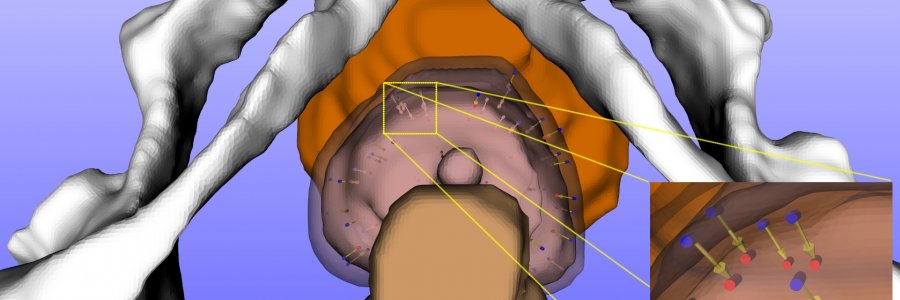Prostate volume changes due to edema occurrence during transperineal permanent brachytherapy should be taken under consideration to ensure optimal dose delivery. Available edema models, based on prostate volume observations, face several limitations. Therefore, patient-specific models need to be developed to accurately account for the impact of edema. In this project we present a biomechanical model developed to reproduce edema resolution patterns documented in the literature. Using the biphasic mixture theory and finite element analysis, the proposed model takes into consideration the mechanical properties of the pubic area tissues in the evolution of prostate edema.

Male pelvic region mesh generated from CT image segmentation
Edema simulation, complete time-course, swelling during Day 1 and return to initial state at Day 30

A super-imposed 3D representation of the pubic organs of interest. The prostate deformation and seeds’ displacements between Day1 and Day30 is shown. The zoomed inset shows the displacement of the seeds from their position at Day1 (blue) to their nal position at Day30 (red)
The model’s computed deformations are incorporated in a Monte Carlo simulation to investigate their effect on post-operative dosimetry. The comparison of Day1 and Day30 dosimetry results demonstrates the capability of the proposed model for patient-specific dosimetry improvements, considering the edema dynamics. The proposed model shows excellent ability to reproduce previously described edema resolution patterns and was validated based on previous findings. According to our results, for a prostate volume increase of 10–20% the Day30 urethra D10 dose metric is higher by 4.2%–10.5% compared to the Day1 value. The introduction of the edema dynamics in Day30 dosimetry shows a significant global dose overestimation identified on the conventional static Day30 dosimetry. In conclusion, the proposed edema biomechanical model can improve the treatment planning of transperineal permanent brachytherapy accounting for post-implant dose alterations during the planning procedure.
Publications:
Mountris K A, Bert J, Noailly J, Rodriguez Aguilera A, Valeri A, Pradier O, Schick U, Promayon E, Gonzalez Ballester M A, Troccaz J, Visvikis D, (2017). Modeling the impact of prostate edema on LDR brachytherapy : a Monte Carlo dosimetry study based on a 3D biphasic finite element biomechanical model Physics in Medicine and Biology 62 pp 2087–2102
